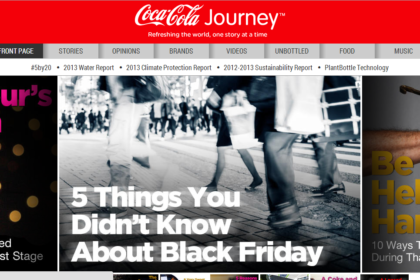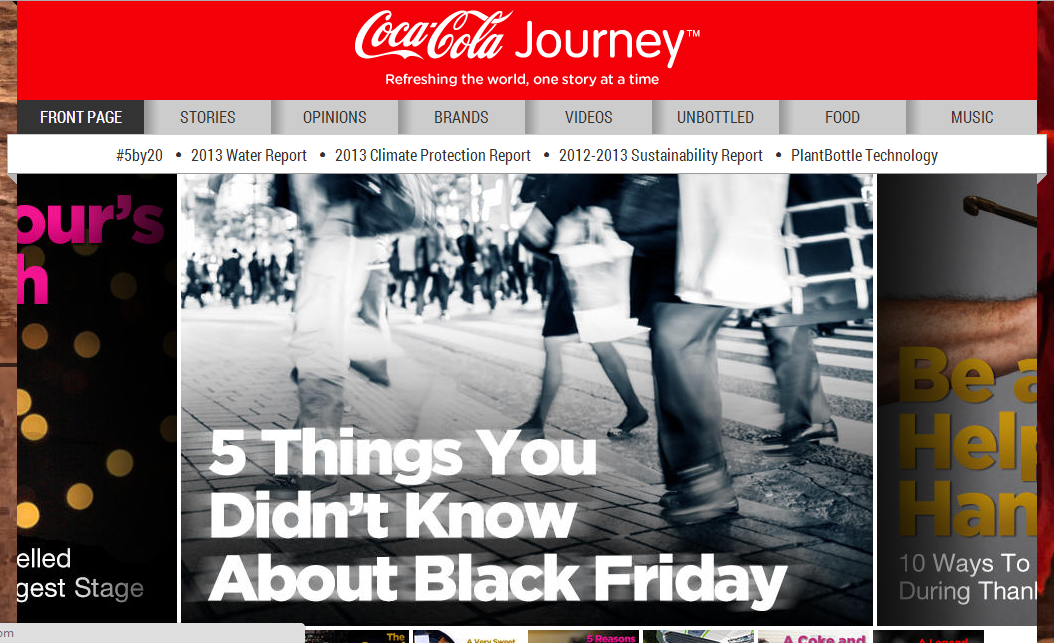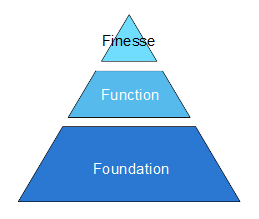
Bob Barker, Austin based managing partner of 20/20 Outlook LLC, joins me as co-author in this exploration of the future of the corporate website. Drawing upon many years experience, as a senior executive in startups and billion dollar companies, Bob acts as a trusted advisor; converting CEO vision into executable strategies that accelerate growth.
The flurry of excitement over Coca-Cola’s new website comes as little surprise as our expectations of brands continue to evolve from that unsophisticated consumers, catered to by corporate marketing, to demanding, astute, and fickle individuals. As a result, content is king and quality is his queen. As evidence of this, we need look no further than the CNN-like homepage, with its shades of a gaming website, designed to reinforce your passion for Coke.
Buzz Builders’ Michelle Mehl recently used Coke’s website to asses the impact of richer content on corporate web sites.
“[The] Web site template of – ‘About Us, In the News, Services, Products, Contact Us, FAQ, a Search Box, Blog, Shopping Cart’ – will no longer work… we all have to start thinking more like publishers, reporters, bloggers, reviewers, and authors.”
Bottom line? Companies need to create a clear, consistent narrative to which others can relate. After all, All Marketers are Liars. What CocaCola is trying to do with the new site is to aggregate and present engaging content that forms a narrative reinforcing the image they want to project.
Our immediate impulse to redo our business website to emulate Coke’s cool presence “cools” when we realize the level of effort it would take, not just to create it, but to maintain it. Doesn’t it? Or does it? Those responsible for most sites, even corporate ones, can’t afford a pivot such as Coke’s. It takes resources to feed such an engine; what is evident though is that it’s imperative for smaller enterprises (i.e. almost all of us) to enright our web site narrative.
How do we do that?
- Add engaging content. I could have easily said “video content” since that’s a proven engaging format. If you don’t have the penchant for the pen, make a 3 minute video that tells your story.
- Change the content often. That can be as simple as adding a blog of vlog (video version) and updating it regularly, whether monthly, weekly, or daily.
- Be willing to experiment. Employ some “disciplined dreaming” to deliberately step outside the usual topics and expand your audience.
With those ideas in mind, is it really that difficult to pivot your site to that of a publisher-like experience? There are two key considerations to understanding the return on making such a change to your site.
1. Advertising has changed.If you’re business still focuses on radio, tv commercials, print ads, or even traditional online advertising, you are falling behind. Don’t let positive results nor growth blind you to your position in the market relative to your competitors. Consumers today engage with businesses online. There was a time when we would have said, “increasingly engage with business…” but this revolution is no longer ongoing; consumer behaviour isn’t shifting, it has shifted. Whether or not consumers do business with you is a result of the quality of your business on the internet, your website, and how effectively you engage and support customers on social forms of media. |
I avoided using the term “social media” as we don’t want you to have the misconception that you must be on Twitter or Facebook; rather, business must understand the role of interactive form of media that enable consumers to engage in real-time – Yelp, Angie’s List, YouTube and video, content marketing the likes of which Coke is pursuing; those are all forms of social media.
Shift your resources, and budgets, to enable your interaction herein. What once went to radio might now fund the infrastructure required to monitor, measure, and optimize everything you are doing. If you fail to do this, know that your competitors are. What becomes of a business that fails to engage their consumers where they prefer to be found and constantly strives to improve?
2. It isn’t as expensive as you might think.
 The beauty of technology is that innovation continually drives down cost. Whereas the cost of your TV spots remain relatively the same, adjusted for demand, digital marketing gets less expensive, year after year.
The beauty of technology is that innovation continually drives down cost. Whereas the cost of your TV spots remain relatively the same, adjusted for demand, digital marketing gets less expensive, year after year.
Where once, the development of a website required programmers, expensive hosting or server costs, and ongoing maintenance running your bills into the many tens of thousands, almost any website you might conceive of today can be built for a fraction of that cost, without developers.
What we need to appreciate investing in is the shift in your philosophy from that of advertising to, truly, marketing. Transforming your corporate website to one like that of a publisher, requires an understanding of your mission and passions, your audience and customers, active participation on your part, and other technologies that help automate your growth by tracking visitors, capturing leads, and even following up on your behalf.
Gone entirely are the days of the static website. Your site is not a brochure but a living extension of your business. Ask yourself simply, first, if it is indeed that; then look to your market and evaluate if you’re keeping up. Grab a Coke, and get to work being engaging.


[…] wrote in 2013, with Cybernance Co-founder and cybergovernance editor Bob Barker, about the evolution of […]
[…] I wrote in 2013, with Cybernance Co-founder and cybergovernance editor Bob Barker, about the evolution of Coca-Cola’s website from the typical corporate brochure-ware to media site and in it suggested that companies need to create a clear, consistent narrative to which others can relate. All Marketers are Liars (says Seth Godin) and evident in what Coca-Cola was trying to do with the redesign, was to aggregate and present engaging content that forms a narrative reinforcing the authentic and relate-able brand that is Coca-Cola. […]
[…] Content marketing devolved into “content for content’s sake,” driven by the mantra that “content is king.” […]